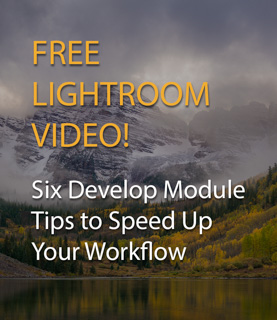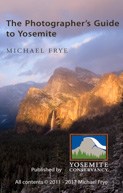Announcements
by Michael Frye | Dec 9, 2009 | Announcements, Workshops
 Do you have a love-hate relationship with Photoshop? You’re not alone. One the one hand, it’s an incredibly powerful tool, capable of doing fantastic things. You know that if you mastered this program you could get the most out of your images and make beautiful prints. On the other hand, Photoshop can be cryptic, complex, and confusing. The learning curve can seem downright crooked.
Do you have a love-hate relationship with Photoshop? You’re not alone. One the one hand, it’s an incredibly powerful tool, capable of doing fantastic things. You know that if you mastered this program you could get the most out of your images and make beautiful prints. On the other hand, Photoshop can be cryptic, complex, and confusing. The learning curve can seem downright crooked.
I was lucky. When I first started using Photoshop in the late ’90s, I got to spend a weekend with Bill Atkinson, who probably knew more about digital imaging than anyone else in the world at the time (maybe he still does). He started me in the right direction and helped me avoid the confusion caused by gathering random bits of information from books and the internet. Like Charlie Cramer, Keith Walklet, and many other fine-art photographers Bill taught, I still use a variation of the simple, powerful, and flexible workflow that Bill showed me.
I’ve since taught Photoshop (and now Lightroom) skills to dozens of people in workshops for West Coast Imaging and The Ansel Adams Gallery. I try to make the complexities of Photoshop easy to understand. The truth is that Photoshop is simple. Anyone can learn to use it. And if you’re already familiar with it, you can learn to harness its full power. The secret is that you don’t have to deal with most of the tools. If you learn to use a few powerful tools well, you can do almost anything in Photoshop.
My next workshop with The Ansel Adams Gallery, Digital Printing and the Zone System (January 19 – 23, 2010) is designed for people who already have some Photoshop experience but want to master this powerful beast. You’ll learn both simple and advanced techniques for getting the most out of your images and making beautiful, fine-art prints. I included the Zone System in the title because getting good exposures in the field is vital to getting good results in Photoshop, so we’ll be working with the entire process, from capture to print. The Zone System also gives us a framework for understanding contrast throughout the workflow—an important tool in this age of HDR. Here’s a partial list of the topics covered:
– Zone System Exposure for Digital Cameras
– Color Management
– Overall workflow
– Raw Image Processing
– Making a Master File
– Using Layers for Flexibility
– Controlling Contrast
– Mastering Curves
– Flexible Dodging and Burning
– Retouching
– Making Difficult Selections Easy
– Converting to Black and White
– Sharpening
– Combining Images for Greater Depth of Field
– Combining Images to Expand Dynamic Range, both with HDR and Photoshop
There’s still space available in the class if you’d like to join us. Click here to register or get more information.
So how do you feel about Photoshop? Do you love it, hate it, or both? And if you’ve learned to love it, how did you get there?
By the way, I’m planning to add more Photoshop tips and tutorials to my web site soon, but for now here’s one tip that you might find interesting, about imitating the effect of a graduated neutral-density filter.
by Michael Frye | Dec 3, 2009 | Advanced Techniques, Announcements, Video Tutorials
Rich Seiling recently added two excellent Photoshop video tutorials to his blog, Crafting Photographs. Rich is the founder and president of West Coast Imaging, and an expert on all things related to digital printing, so when he gives out free information like this it’s definitely worth checking out.
by Michael Frye | Nov 30, 2009 | Announcements, Yosemite Photo Conditions

Saturday evening I joined dozens of photographers in the Ahwahnee Meadow to see the celestial encore of Ansel Adams’ famous Moon and Half Dome image. Don Olson of Texas State University had predicted that the moon would be in almost the same spot as when Ansel made his photograph in 1960. In the meadow Saturday were two of Ansel Adams’ former assistants, Alan Ross and Ted Orland, seen in this photo (Ted is the one pointing). A large group of park rangers took a group portrait, and Delaware North, the park concessioner, even set up a little stand at the edge of the meadow serving free hot chocolate.
There was just one small problem: no moon! The sky was mostly clear, but a persistent band of clouds behind Half Dome hid the moon. Nevertheless, we all had a great time—the lunar no-show didn’t really seem to matter. I’ve posted more photos on The Ansel Adams Gallery’s Flickr group.
Afterward the Gallery hosted a reception for Alan Ross and his beautiful new exhibit, Visions of Yosemite and the West. I talked with Alan about the contact sheet of images Ansel made that evening in 1960; it’s an unusual glimpse into the thought process of a master photographer. Although this JPEG is small, you can see that Ansel actually bracketed exposures! By four stops! Yes, Mr. Zone System hedged his bets. Wouldn’t you in this situation? Also, he apparently didn’t wrap the roll of film tightly (he made this image with a Hasselblad and 120 film), and there was a light leak. Luckily only the edges were damaged, otherwise the world would never have seen this fantastic photograph.
I was also struck by the different compositions he framed. We tend to think that a master like Ansel would have such a clear concept in his mind that he would only need one composition. And in fact the first frame here is, I believe, the one that became famous (I could easily be wrong about that). But he also pointed the camera at Mt. Starr King, then put on a shorter lens and photographed the top of the Royal Arches cliff and the moon above Half Dome again. If you look closely you’ll also notice that Ansel shifted the camera slightly to the left and right for the first four frames, where he bracketed exposures. Was he unsure about the precise framing? This seems odd since he wrote in Examples that he visualized the cropping from the start. The contact sheet shows that after bracketing those first four exposures Ansel composed an image of Mt. Starr King, then came back to the moon rising above Half Dome, but this time with slightly different framing, pointing the camera more to the left than previously, then more to the right. It seems that he was bracketing compositions as well as exposures.
This is something I do frequently. You can’t always tell what really works by looking through the viewfinder or at the camera’s LCD screen. If I’m not sure whether composition A or B is better, I do both. It’s nice to know that Ansel wasn’t immune from this uncertainty!
What all this points out is that even the best photographers sometimes make mistakes, and aren’t always sure about the best composition or exposure. We’re all striving to get better; some are just farther along the path than others. Ansel certainly traveled farther than most of us ever will.
by Michael Frye | Nov 25, 2009 | Announcements

I have a lot to be thankful for. My son started college this year at Humboldt State. He’s adjusted well, is getting good grades, and seems to be having a great time. It’s good to have him home this week. My wife Claudia and I have been happily married for 23 years. We have great friends, live in a wonderful place, and I make my living doing what I love—photography. And I’m very thankful for all of you, my blog readers, workshop students, and fellow photographers. You make my job fun!
Happy Thanksgiving! Our dogs Bear and Rider wish you were here.
by Michael Frye | Oct 15, 2009 | Announcements

As I mentioned on October 7th, I’ll be doing two additional workshops for The Ansel Adams Gallery in 2010:
Digital Printing and the Zone System
January 19 – 23
After taking my Photoshop Fundamentals or Digital Landscape workshops, many students have asked for a more advanced Photoshop class. New tools like HDR (High Dynamic Range imaging) have also made me rethink some of my working methods in recent years. So I thought it was time to do a comprehensive course in Photoshop and digital printing for landscape photographers that incorporates these new tools.
As digital cameras and software have grown in sophistication, they’ve given us unprecedented control of our images. Such power creates wonderful opportunities, but can also lead to confusion. How do you apply these controls? Luckily we have something to guide us, because the new working methods bear a striking resemblance to Ansel Adams’ Zone System. The tools are quite different, but the goals are the same: to control contrast—either increasing contrast in flat light, or decreasing it when the light would otherwise be too harsh. In this class we’ll investigate methods for mastering this vital aspect of printing, starting with Photoshop’s most powerful tool, Curves, and continuing with techniques for expanding dynamic range, either by blending multiple images in Photoshop, or with HDR (high dynamic range) software. But we’ll cover much more than that, including Zone System exposure for digital cameras, and all the essential steps for making great digital prints like color management, dodging and burning, advanced selections, sharpening, and… well you can see a more comprehensive list on the Gallery’s web site.
Hidden Yosemite
July 7 – 11
After moving the workshop to Yosemite Valley on 2009, we’re returning to the beautiful Yosemite high country next year. I’ll be using my 25 years of Yosemite experience to guide students to great locations that most photographers miss. Short day hikes will lead us to cascading creeks, ridge top views, and alpine lakes. We’ll also delve deeply into the mysteries of exposure, light, and composition. Click here to see more details.
by Michael Frye | Oct 7, 2009 | Announcements, Workshops
I’ll be announcing two additional 2010 workshops with The Ansel Adams Gallery soon—stay tuned for details.
 Do you have a love-hate relationship with Photoshop? You’re not alone. One the one hand, it’s an incredibly powerful tool, capable of doing fantastic things. You know that if you mastered this program you could get the most out of your images and make beautiful prints. On the other hand, Photoshop can be cryptic, complex, and confusing. The learning curve can seem downright crooked.
Do you have a love-hate relationship with Photoshop? You’re not alone. One the one hand, it’s an incredibly powerful tool, capable of doing fantastic things. You know that if you mastered this program you could get the most out of your images and make beautiful prints. On the other hand, Photoshop can be cryptic, complex, and confusing. The learning curve can seem downright crooked.










